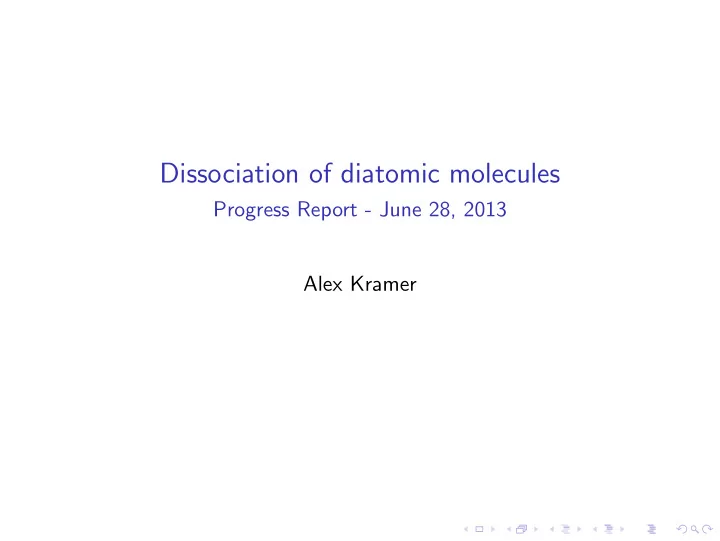

Dissociation of diatomic molecules Progress Report - June 28, 2013 Alex Kramer
CO + molecule - molecular potentials, dipole couplings ◮ Potentials digitized from literature, interpolated and fit to 2nd order (Morse) approximation ◮ Dipole couplings calculated using Hartree-Fock SCF calculations with GAMESS quantum chemistry software ◮ Difficulties relating to “spaghetti” of low-lying CO + states Figure: Low-lying CO + potential curves [1]
CO + molecule - dipole coupling issues ◮ Electron configuration degeneracy in GAMESS output ◮ Disagreement within literature and with calculated values Figure: CO + 1 4 Π − a 4 Σ + dipole coupling results
CO + - vibrational revivals Calculated vibrational revival times and power spectra for available doublet and quartet states of CO + Figure: CO + A 2 Π vibrational revival
CO + - vibrational revivals Figure: CO + A 2 Π vibrational revival power spectra
CO + - Franck-Condon factors → CO + � � X 1 Σ + � A 2 Π � Figure: CO Franck-Condon coefficients
CO + - next steps ◮ Simulate 1- and 2-color IR pump-probe spectroscopic experiments and compre with experimental kinetic energy spectra ◮ Refine dipole coupling and potential curve calculations with GAMESS, including more realistic fittings ◮ Investigate C, O + vs. C + , O dissociative channels
Other projects ◮ Continuing work with vibrational revival and 2-color IR pump-probe spectroscopy simulations of noble gas dimers to reproduce earlier results ◮ Isolating computational performance issues - looking into ways to parallelize existing code using OpenMP or MPI ◮ Investigating using split-operator Fourier transform propagation in place of split-operator Crank-Nicholson propagation
References [1] Okada, K. and S. Iwata. “Accurate potential energy and transition dipole moment curves for several electronic states of CO + .” J. Chem. Phys. 112.4 (2000): p.1804-1808.
Recommend
More recommend